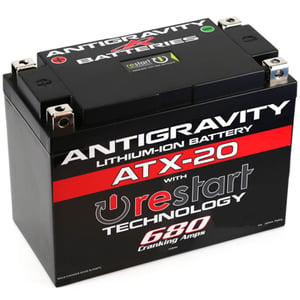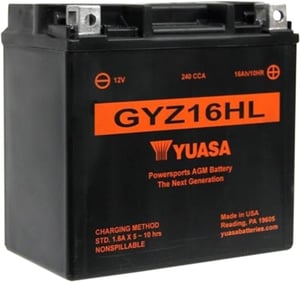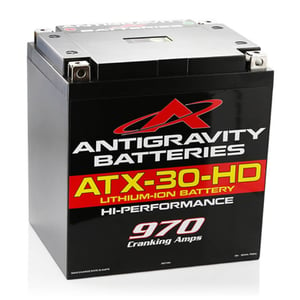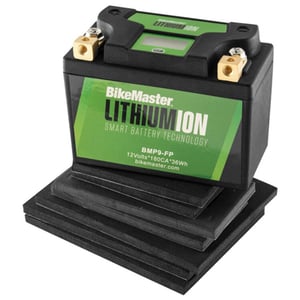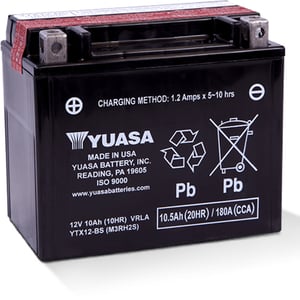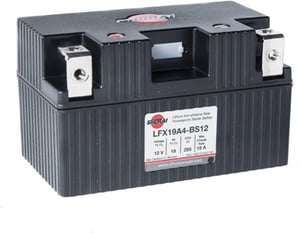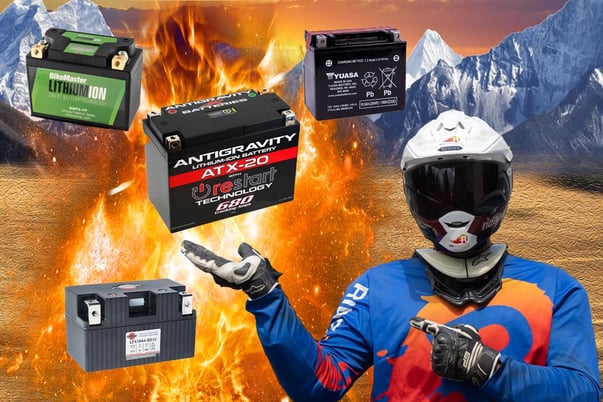 Disclosure: RIDE Adventures is a participant in the Amazon Services LLC Associates Program as well as other affiliate programs, designed to provide a means for us to earn fees by linking to Amazon and affiliated sites at no extra cost to you. Please see our Disclosure for more details.
Disclosure: RIDE Adventures is a participant in the Amazon Services LLC Associates Program as well as other affiliate programs, designed to provide a means for us to earn fees by linking to Amazon and affiliated sites at no extra cost to you. Please see our Disclosure for more details.
All motorcycle batteries have a shelf life. Whether yours is stone dead or clearly on its last legs, you might as well upgrade it if you've gotta spend the money anyway.
Conventional wisdom (and years of trial and error) tells us that a good motorcycle battery should last somewhere between 2 and 5 years.
That leaves an awfully large margin of error if you're trying to figure out whether or not yours needs replacing, although a volt meter and a little know-how can go a long way too.
Still, these things do have a shelf life, and some bikes are harder on batteries than others. As a general rule of thumb, it's always better to replace your motorcycle battery proactively rather than roll the dice on a no-start situation down the line, and you might as well treat yourself while you're at it.
 "You sure wouldn't want to roll the dice on some of our rides in the Southwest!"
"You sure wouldn't want to roll the dice on some of our rides in the Southwest!"While the usefulness of upgrading your battery from the OEM model is a topic of some debate, we've found it's almost always money well spent.
Below we'll touch on a few of the most common talking points around upgrading your battery, as well as our choices for the best motorcycle battery upgrades currently on the market.
Quick List of Motorcycle Battery Upgrades
Does It Matter What Battery You Put In Your Motorcycle?
No one in their right mind wants to waste money on upgrades that don't actually serve a useful purpose. Most OEM motorcycle batteries are long-lasting and reliable when properly maintained, but in our experience, not all batteries are created equal.
Consider the fact that today's motorcycles come with three distinctly different types of batteries: traditional lead acid, AGM, and lithium-ion. Before we get into specific brands, it's important to note that simply changing the type of motorcycle battery you're using can make a big impact.
This is particularly true if you're still using a traditional liquid lead acid model, as these batteries are subject to spilling and leakage, especially if mounted at an angle or stored incorrectly.
Lead acid batteries also require more maintenance as their fluid levels need to be monitored and topped off from time to time.
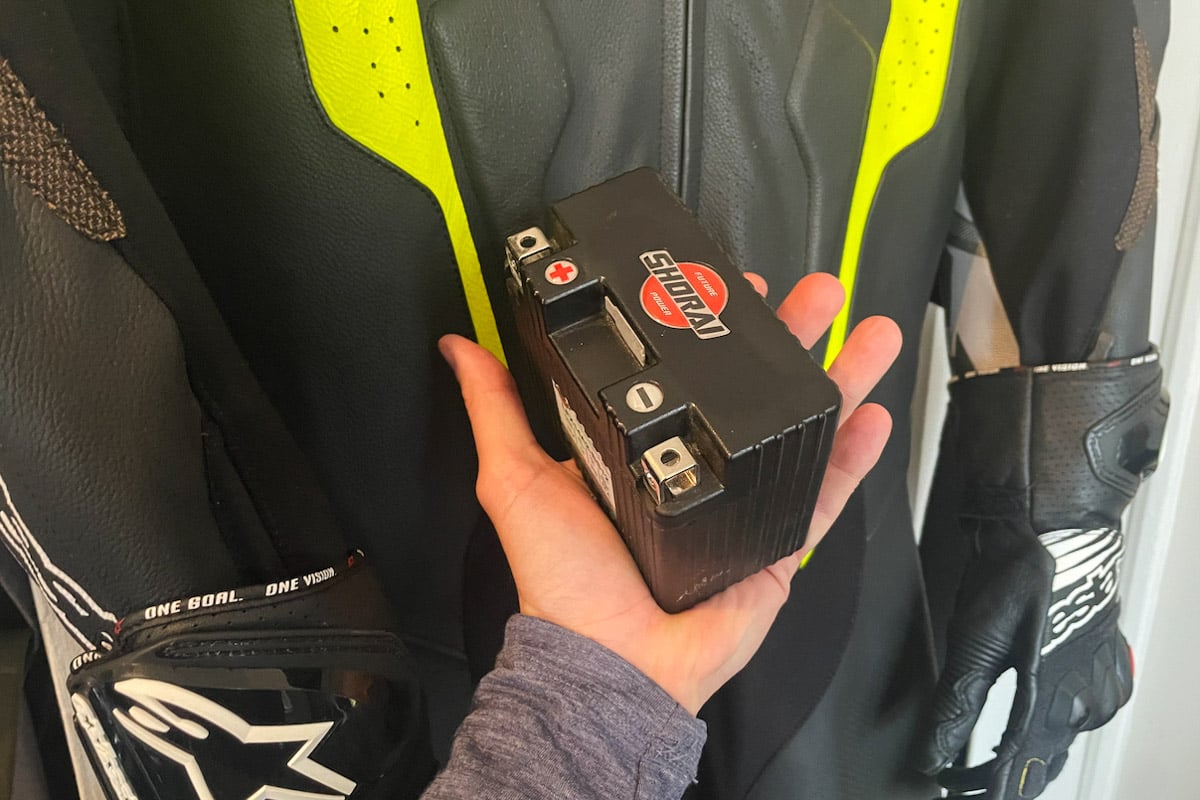 "Thought we'd show you just how small and light these lithium batteries can get."
"Thought we'd show you just how small and light these lithium batteries can get."AGM batteries, on the other hand, deliver the same reliable performance as lead acid, but are both spill-proof and maintenance-free.
This also means that unlike lead-acid batteries, AGM batteries can be mounted at any angle (or even upside down), which is ideal for custom bikes or anyone who needs to relocate their battery to make room for upgrades and farkles.
The same goes for lithium-ion batteries, except lithium models have the benefit of being maintenance-free, unspillable, and much lighter and more compact than their leaden counterparts. So yes, the type of battery matters, but what does that mean for your bike?
So What Battery Is Best For A Motorcycle?
The short answer to this question is "any reliable brand that works for you" but if we want to get objective about which type and/or brand is the best overall, we'll need to dig a little deeper.
For most riders in most applications, an AGM battery made from a reputable brand (Yuasa, BikeMaster, etc.) is all you'll ever need.
If you want to upgrade beyond AGM, you're going to be getting into lithium territory, which we've used on numerous bikes with great success. There's a lot of bad information surrounding lithium motorcycle batteries though, so let's take a moment to clear the air here.
1.) Lithium Batteries Require Special Charging Systems
This is one we hear a lot, and is completely false. Some folks like to point out that motorcycle charging systems are designed to recharge lead-acid batteries only, and can't provide the juice or complexity needed to keep a lithium battery alive.
Every lithium motorcycle battery made today by a reputable manufacturer comes with an integrated BMS (battery management system) stored inside the housing of the battery.
This BMS functions as the battery's "controller" ensuring proper voltages are delivered to the battery and preventing overcharge/overheat situations.
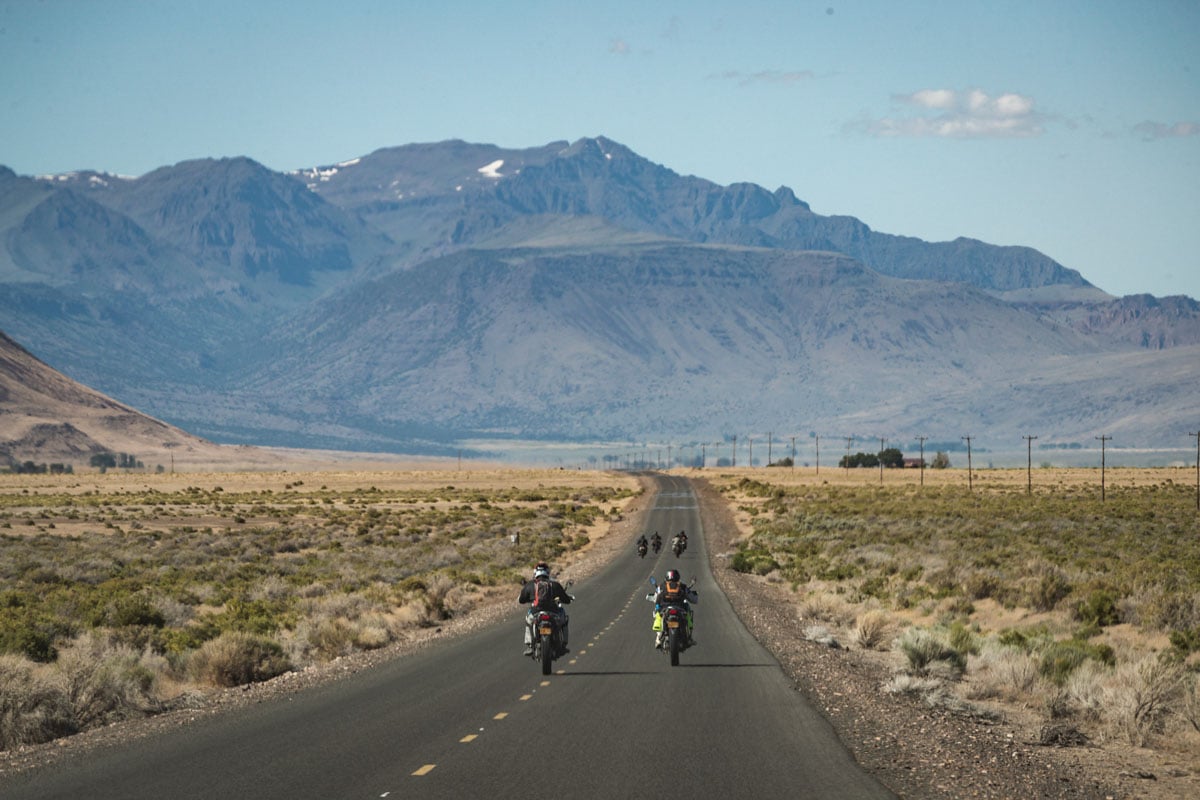 The only exception to this rule is that not all motorcycle battery chargers (as in a trickle charger, battery tender, etc.) are good for lithium batteries.
The only exception to this rule is that not all motorcycle battery chargers (as in a trickle charger, battery tender, etc.) are good for lithium batteries.
Most chargers work just fine (many models nowadays even come with selectable modes for either type), but the only thing you need to worry about are chargers with "desulfation cycles" because they deliver an initial spike of current during the initial charging process that can damage lithium cells.
2). Lithium Batteries Don't Work With Older Bikes
This one is partly true, but for 99% of users, a complete non-issue. Today's lithium batteries are designed to function seamlessly with any 12V motorcycle electrical system.
If you've got a bike that's old enough to still run a 6V system, you're better off sticking with a traditional battery for simplicity's sake. For anyone else, again, your battery's BMS will handle your power and charging needs.
3). Lithium Batteries Like To Catch Fire And Explode
Again, we'd point out that lithium battery technology has come a long way since the early years, but we've all seen our fair share of flaming EVs and electric bikes as well.
Luckily for you, lithium motorcycle batteries are made from LiFePO4, not standard lithium-ion cells, which makes them much more stable and effectively non-combustible.
Our Favorite Motorcycle Battery Upgrades
To recap: Unless you're looking for the least expensive battery possible, your replacement battery should be either an AGM lead-acid battery or a lithium one (LiFePO4, specifically). In keeping with that conviction, here are our favorite models of each type.
*(battery number order is random)
1. Antigravity Re-Start Lithium
Antigravity currently makes our favorite lithium motorcycle batteries overall, and is generally our first recommendation if you've got the money to spend.
These little powerhouses are roughly 70% lighter than any lead acid or AGM alternative (and much more compact) while also delivering about twice the cranking amps and twice the lifespan.
What makes the Antigravity Re-Start special, however, is that the folks at Antigravity designed the battery management system to always save enough energy in the battery to jumpstart your bike if needed.
That means that if you left your lights on, left your phone plugged in, or have other issues with parasitic power drain, this motorcycle battery will never leave you stranded.
Essentially this equates to always carrying around a portable jump-starter for your bike without actually having to carry anything at all.
The entire system works by simply pushing a button on the top of the battery, so as long as you have access to your battery tray, you can get back on the road.
PROS |
CONS |
|
|
Antigravity Re-Start Lithium Battery
2. Yuasa Factory Activated AGM
Lithium batteries are great, and while they've improved significantly over the last decade, many riders still prefer the "known factor" of a lead-acid AGM battery.
Yuasa has been the brand to beat for longer than we remember for both AGM and traditional lead-acid batteries, and we've consistently gotten years and years of worry-free service out of Yuasa batteries on our bikes.
 "Yuasa has been the brand to beat for longer than we remember for both AGM and traditional lead-acid batteries"
"Yuasa has been the brand to beat for longer than we remember for both AGM and traditional lead-acid batteries"
Our favorite option in the Yuasa AGM lineup is their "factory activated" motorcycle battery, which ships to your door fully filled, sealed, and charged.
There's no electrolyte solution to mess with, and no waiting period before the battery can be used: simply take it out of the box, throw it on your bike, and go ride.
You'll have to pay a small "convenience fee" for the factory activation (typically about $20 more than a regular AGM cell), but for folks who don't own a battery charger (or just need a functional battery ASAP), that convenience is worth paying for.
We'll also note that Yuasa batteries are a bit more expensive than many "budget brand" motorcycle batteries on the market, but we've found they save us money in the long run as they typically outlast cheaper brands as well.
PROS |
CONS |
|
|
Yuasa Factory Activated AGM
3. AntiGravity HD
While many riders love lithium motorcycle batteries for their dramatic weight savings, not everyone wants or needs a smaller battery.
In fact, one of the biggest inconveniences of switching to an aftermarket lithium cell is finding a way to fill up all that leftover room in your OEM battery box.
That's why we love the AntiGravity HD, which is a lithium battery that's built to the same standard size as your average YTX20 battery. With that larger case comes more room for battery cells, and AntiGravity fills theirs to the brim for unmatched capacity and outrageous cranking amps.
Despite the HD's larger size compared to your typical lithium motorcycle battery, because the cell doesn't rely on heavy metals like lead, it still manages to weigh in at around 5 pounds, which is about 4-5 pounds lighter than your typical AGM battery.
We're particularly fond of this upgrade for larger touring and adventure bikes, especially those with power-hungry accessories like heated seats and GPS units.
PROS |
CONS |
|
|
Antigravity HD Lithium-Ion Battery
4. BikeMaster Lithium Ion 2.0
Our first BikeMaster lithium battery was purchased out of necessity back in 2016. We'd come out to a dead battery on a DR650 we needed to commute to the office, and the BikeMaster Lithium was the only battery in stock at our local Cycle Gear that came fully charged and ready to go.
Long story short, we rolled the dice on this budget-friendly lithium motorcycle battery, and ended up getting seven trouble-free years out of it.
In fact it was still going strong when we sold that bike earlier this year. BikeMaster's latest "2.0" model adds a voltage meter into the mix as well as an upgraded 10 amp recharge capacity that delivers a 90% charge in just 6 minutes.
As far as "budget brand" lithium batteries go, this is the only one we've got experience with that we can heartedly recommend.
We'll also note that BikeMaster is owned by Tucker Powersports, the same company behind many well-known motorcycle brands including ProTaper, Firstgear, Answer Racing, and Speed and Strength, so this isn't some Amazon-special motorcycle battery.
PROS |
CONS |
|
|
BikeMaster Lithium Ion 2.0
5. Yuasa AGM Battery
AGM motorcycle batteries aren't exactly cutting-edge technology, and you'd think that one brand would be just as good as the next.
Unfortunately, many of the "bargain batteries" we've tried over the last few years have suffered from an embarrassingly short lifespan, but a tried-and-true Yuasa battery has never done us dirty.
There's a reason Yuasa batteries are the most popular replacement battery on the market: They just work, and they keep working for years and years. And, because this is an AGM battery, it's maintenance-free, slower to discharge, and completely spill-proof.
Yuasa batteries aren't the cheapest option out there, but they're a known factor worth paying a few extra dollars for in our experience.
With that being said, this standard AGM version will save you a few bucks over the "factory activated" option above, but you'll have to fill it up and charge it yourself before it's ready to use.
PROS |
CONS |
|
|
Yuasa AGM Battery
6. Shorai Lithium Battery
We've had good experiences with Shorai lithium batteries, and handily recommend them as a high-performance upgrade for your factory motorcycle battery.
These lithium cells are comically light and compact while still delivering excellent power and true deep-cycle performance.
 "We ran this Shorai battery in a big 1200GSA for over five years without issue."
"We ran this Shorai battery in a big 1200GSA for over five years without issue."We love Shorai batteries because they often cost a few bucks less than AntiGravity batteries while still delivering the same weight savings and similar performance.
The cold cranking amps are typically lower and there's no jump start or voltage display feature, but as a bare-bones performance battery, a Shorai gets the job done for less cash.
PROS |
CONS |
|
|
Shorai Motorcycle Battery
7. Fire Power Factory Activated AGM
If you're looking for a reliable, plug-and-play battery for as little cash as possible, Fire Power's factory-activated AGM gets the nod from our team. These batteries are built well, ready to crank straight out of the box, and in most applications only cost about $100.
There may be a few brands out there that do it for slightly less cash, but personally we believe going any cheaper than a Fire Power battery is asking for trouble.
We've tried a few off-brands ourselves over the years, and more often than not they're cooked after 12 months for one reason or another.
Fire Power's reputation can't match major players like Yuasa though, and while we haven't heard any serious quality or reliability issues, we'd expect some of the more established brands to last a bit longer.
We'll also note that some owners report buying Fire Power batteries that don't match the dimensions of the OEM battery, so save that receipt in case you run into a fitment issue.
PROS |
CONS |
|
|
Fire Power AGM Motorcycle Battery
Our Final Thoughts On the Best Motorcycle Batteries
While a motorcycle battery isn't exactly the "sexiest" upgrade you can buy for your bike, it very well may be the most bang for your buck out there.
Consider how much money you usually have to spend to shave a single pound of weight off a high-performance motorcycle, then compare that to the typical 4-6 pound weight savings baked into the cost of a lithium battery.
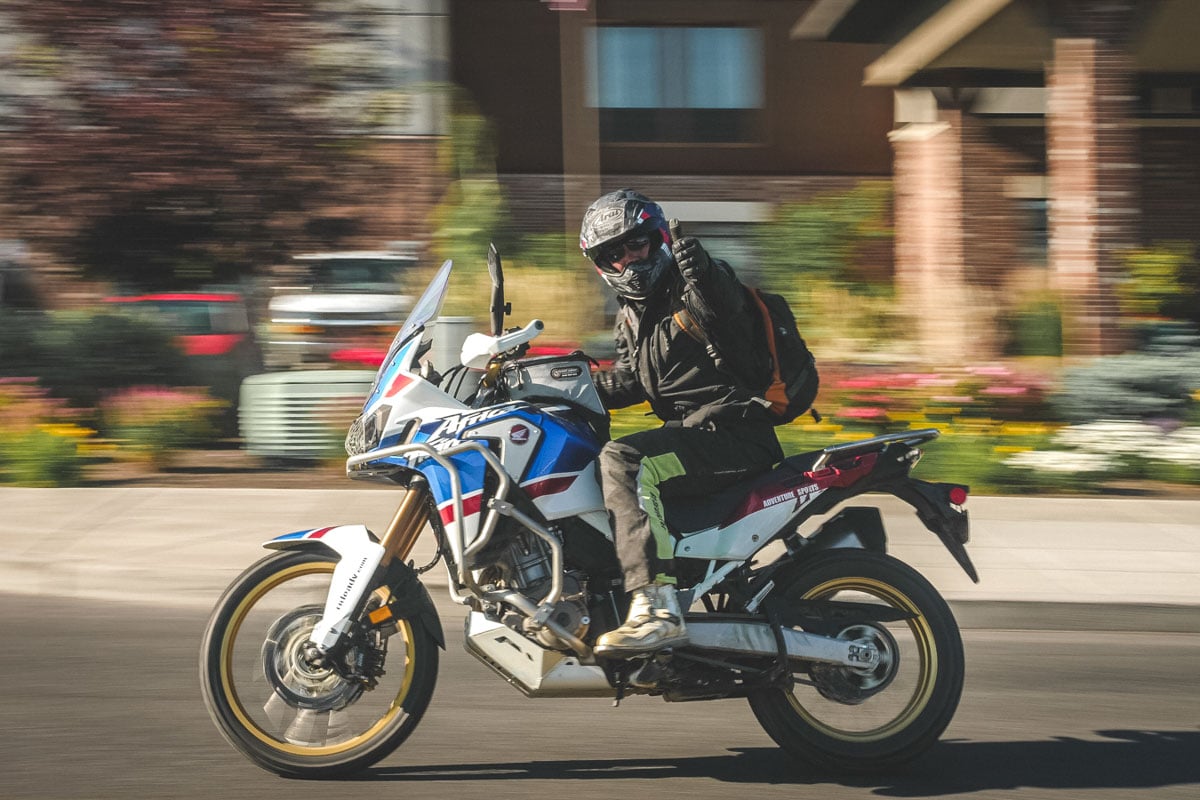 "We hope this article got you squared away on which motorcycle battery to get. Let us know which one you chose in the comments."
"We hope this article got you squared away on which motorcycle battery to get. Let us know which one you chose in the comments."All things considered, we believe there's a lot of misinformed criticism out there about lithium motorcycle batteries. As far as we're concerned the only valid complaint worth making about any modern lithium option from a reputable brand is that they're expensive, which they absolutely are.
For those without the cash or inclination to make the jump to lithium, you just can't go wrong with a Yuasa AGM upgrade, and as far as we're concerned, the discussion ends there.
→Read More:
No BS Guide on Lubing Your Motorcycle Chain
How to Get Into Big Bike Adventure Riding if You’re New to Dirt















